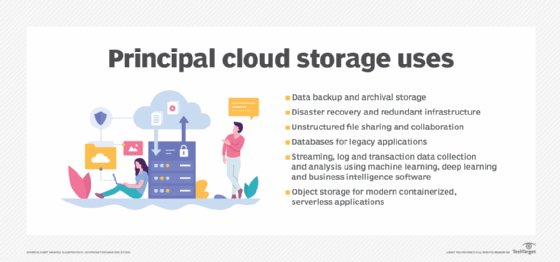
How to effectively plan cloud storage scalability
Changes to an organization, such as a merger, acquisition or release of a new product, can result in a domino effect on the firm's IT infrastructure. These changes can specifically affect the data storage infrastructure and require additional capacity in a short time frame.
As a result, the ability to scale storage resources to accommodate a business need is essential. That's where cloud storage scalability has become a key piece of the planning process.
Differences in scalability needs
A storage scalability strategy is based on an organization's ability to increase capacity quickly to meet business needs.
For situations that an organization can identify in advance, such as a merger or product release, the business must use that knowledge to properly implement changes in IT requirements, particularly data storage.
In environments where primary storage is on site, storage administrators will have time to research requirements they may need by meeting with the affected business unit leaders. Admins can research and order additional resources -- such as more storage capacity and increased bandwidth to a SAN -- in time to handle the changes.
However, some situations may not occur with advanced warning. They might include a sudden, hostile takeover by another company; acquisition of a new product from another company; or a quick launch of a new service offering based on a response to competition.
In each of these cases, admins may not have sufficient time to adjust IT infrastructure resources to handle the change, so a more rapid, active scalability is necessary.

Cloud storage scalability benefits and limitations
Cloud-based storage is an important option, as it is available almost immediately and can scale to fit a customer's new requirements. It removes the need for ordering hardware and software, or for additional equipment space. It also minimizes the need for additional network bandwidth. Admins can configure cloud storage to perform the same as an on-site storage array, without the additional overhead and possible capital expenditures needed to acquire the resources.
Admins must decide whether to use cloud in a hybrid arrangement or as the primary storage platform. For many organizations, legacy on-site storage is not likely to disappear overnight. As such, a hybrid configuration is the most appropriate infrastructure, using cloud storage to handle normal business growth and for emergency requirements such as quick scalability or disaster recovery (DR).
Assuming cloud storage resources are secure and accessible by authorized users, they can form an important part of the firm's business continuity, technology disaster recovery and cybersecurity strategies. If the primary IT resources are disrupted or damaged, cloud-based resources -- configured for DR -- can quickly recover applications, virtual machine images, files and databases.

In addition, data is growing at an exponential rate, so businesses need to have the storage infrastructure in place to keep up with it. The cloud is an important part of an overall storage strategy. Businesses can use cloud resources to stay in front of potentially massive increases in data storage. Cloud storage scalability reduces the need for additional floor space and other infrastructure resources, such as power and HVAC. Admins can deploy and disconnect cloud storage with minimal disruption to IT operations.
Cloud storage scalability planning
Availability of cloud storage and its scalability features is a key component of storage resources planning. The following steps provide key considerations for adding capacity and will help in the process of determining if scalable storage resources are appropriate for an organization.
- Analyze current, previous and anticipated storage requirements based on trending analyses; some software applications can perform these activities.
- Discuss storage requirements with business unit leaders to learn of any situations that may affect those requirements.
- Use storage as a service (STaaS) from cloud or managed service providers, as it provides a dial-up capability for deploying storage resources as needed, adjusting quickly.
- Look for "storage on demand" services from cloud vendors, which can provide storage bandwidth when needed, with minimal ramp-up and deployment times, like STaaS.
- Determine the role cloud storage will have for the organization, such as on-demand storage resources, rapid and agile deployment of applications and disaster recovery.
- Use scalable servers that IT can quickly reconfigure to handle mission-critical, highly data-intensive activities.
- Consider scalable storage software that can create software-defined storage, manage SAN fabrics, manage storage devices plus cloud storage, provide scalable storage space for demanding workloads, and use AI for better storage analysis and planning.
- Consult with cloud storage vendors to understand their capabilities based on user requirements. Major cloud vendors offer highly scalable resources and a variety of pricing options.
- If possible, test a cloud vendor's storage capabilities before going to contract.
IT should regularly review cloud storage scalability requirements so that the organization can satisfy unanticipated needs.
© 2021 LeackStat.com
